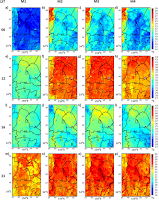Here we show that local climate mitigation can reduce the impacts of climate change, with the analysis of a new development area in Sydney, 50 km from the coast.
With meso-scale climate modelling, we computed that by 2050 the peak summer temperature will increase by 0.8 °C and the daily average summer temperature by 1.6 °C. Mitigation with cool materials, greenery, and irrigation will lower the peak and average daily temperatures respectively by 2.2 °C and 1.6 °C with respect to the unmitigated future climate scenario.
Mitigation techniques when applied in the whole Sydney area yield to cooling energy needs reductions by 6.7–8.6 kWh/m2 (13.4–19.3%) for typical residential, office, and school buildings, with a negligible heating penalty, compared to an unmitigated future scenario. Combined adaptation and mitigation can reduce the future cooling energy needs by 31.3 kWh/m2 (70%), 29.3 kWh/m2 (57.3%), and 20.9 kWh/m2 (59.4%) for typical residential, office, and school building, respectively. Our study indicates that the consolidated and widely available mitigation technologies alone cannot counteract the energy impact of both global and local climate change. A structured system of interventions at building and urban scale
is necessary while developing novel and higher efficiency mitigation technologies.
1 For More Information : Samira Garshasbi, Shamila Haddad, Riccardo Paolini*, Mattheos Santamouris,Georgios Papangelis, Aggeliki Dandou, Georgia Methymaki, Panagiotis Portalakis, Maria Tombrou: Urban Mitigation and Building Adaptation to Minimize the Future Cooling Energy Needs , Solar Energy, Volume 204, 1 July 2020, Pages 708-719

No comments:
Post a Comment